Mars and Bright Jewels Crown Venus in Evening, and the Moon’s Move to Morning Gives Galaxies Again!
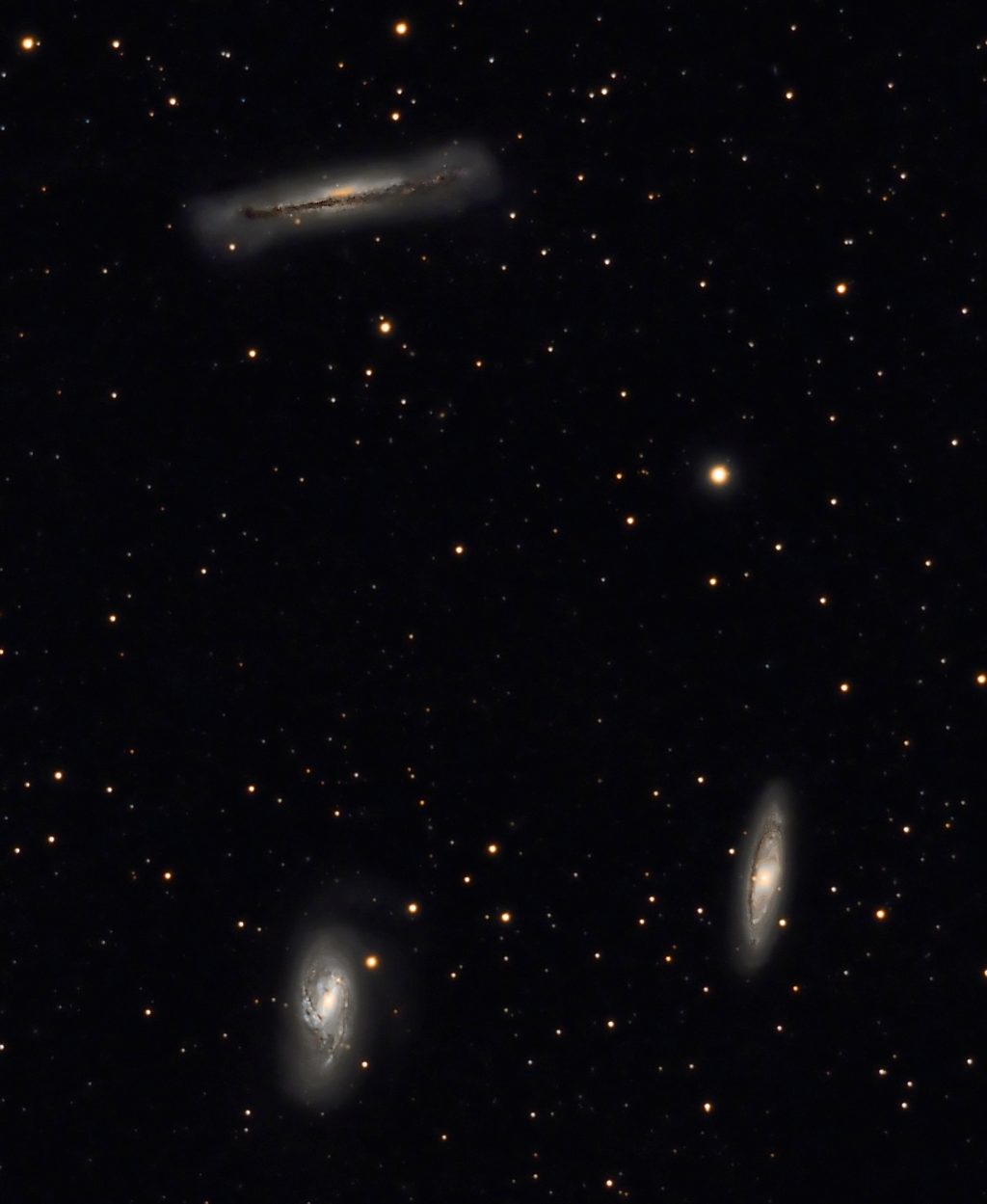
This terrific Wikipedia image by Hunter Wilson from March 28, 2008 shows the Leo Triplet of Galaxies, which is located south-southeast of the bright star Chertan in Leo. The photograph, with celestial north up and East toward left, covers a pinky-finger-width (or 0.6 degrees) of the sky left-to-right. The Hamburger Galaxy is at the top – do you see the patty and the bun? The distorted spiral galaxy M66 is at lower left, and edge-on M65 is at lower right. Hunter’s gallery of wonderful images is available at https://hwilson.zenfolio.com/galaxies
Hello, May Stargazers!
Here are your Astronomy Skylights for the week of May 7th, 2023 by Chris Vaughan. Feel free to pass this along to your friends and send me your comments, questions, and suggested topics. You can also follow me on Twitter as @astrogeoguy! Unless otherwise noted, all times are expressed in Eastern Time. To subscribe to these emails please click this MailChimp link.
If you’d like me to bring my Digital Starlab portable inflatable planetarium to your school or other daytime or evening event, or deliver a session online, contact me through AstroGeo.ca, and we’ll tour the Universe, or the Earth’s interior, together! My terrific book with John A. Read entitled 110 Things to See With a Telescope is a guide to viewing the deep sky objects in the Messier List – for both beginners and seasoned astronomers. DM me to order a signed copy!
The moon will wane and rise later and later this week, leaving evenings worldwide moonless. That allows for a final batch of galaxy-viewing nights, some early summer globular clusters, and a few left-over meteors. The aging moon will visit Saturn and elusive Jupiter in eastern pre-dawn morning sky. Read on for your Skylights!
The Moon
For those of us at mid-northern latitudes this week, the moon will rise late and linger into the morning sky. And, because we are approaching the summer solstice, the night-time moon will stay very low in the sky, while the sun will shine relatively high in the sky at noon. They behave like a teeter-totter! One high while the other is low at the solstices, or equally high near the equinoxes.
Tonight (Sunday) the very bright, 92%-full moon will clear the eastern rooftops around midnight. It will be shining between the bright reddish star Antares in Scorpius (on its upper right) and the Teapot-shaped stars of Sagittarius, the Archer (on its lower left). It will be positioned very close to the centre of our Milky Way galaxy – but its brilliance will hide that subtle glow. By dawn on Monday the tableau will be descending in the south-southwest.
On Tuesday and Wednesday morning the waning gibbous moon will traverse the stars of Sagittarius. By then it will be easy to see its pale form low in the southern sky on your way to work or school. Check it out every morning, but remember that it will be rising about half an hour later each day – so it will hop farther and farther east through this week.
The half-moon will swim through the faint stars of Capricornus (the Sea-Goat) on Thursday and Friday. The moon will officially reach its third quarter phase at 10:28 am EDT, 7:28 am PDT, or 14:28 Greenwich Mean Time on Friday, May 12. At third (or last) quarter the moon appears half-illuminated, on its western, sunward side. Since third quarter moons rise in the middle of the night, the week of dark, moonless evening skies that follow this phase are the best ones for observing deep sky targets.
Early risers on Saturday morning can see the waning crescent moon shining prettily in the southeastern sky with the prominent, yellowish dot of Saturn shining a slim palm’s width to the moon’s upper left (or 5 degrees to the celestial north). They’ll clear the treetops, with the modest stars of Aquarius (the Water-Bearer) surrounding them, at around 4 am local time. The brightening sky will hide Saturn by 6 am. For observers in more westerly time zones, the moon will be a little closer to Saturn, allowing them to share the view in binoculars.

On Sunday morning, the crescent moon will hop east to shine to Saturn’s lower left, very closely below the widely-spaced stars Psi1 and Psi2 Aquarii, which mark the water stream pouring from his pitcher. You should be able to see both stars with your unaided eyes – or use binoculars. In Toronto that moon will cross in front of, or occult, nearby Psi3 Aquarii from 4:47 to 5:54 am EDT. The waning, partially-illuminated moon will look gorgeous through binoculars and telescopes all week long!
The Planets
Once again this week, Venus and Mars will be the only planets we can see during the evening. They’ll shine in the lower half of the western sky after sunset, with far brighter Venus catching your eye even before the sun has fully set. The rest of the planets are either close to the sun or shining in the eastern sky before dawn.
Magnitude -4.2 Venus will be surrounded by the bright stars of the Winter Hexagon asterism. You might spot reddish Aldebaran in Taurus twinkling just above the west-northwestern horizon, and the brighter, whiter star Sirius well off to its left – before they set around 10 pm. Reddish Betelgeuse will shine 1.9 fist diameters to Venus’ lower left (or 19° to the celestial south). Meanwhile, a set of very bright stars will form a curved line, called the Arch of Spring asterism, over Venus. From left to right (or celestial southeast to northwest) they are white Procyon (Alpha Canis Minoris), white Castor and golden Pollux (Alpha and Beta Geminorum respectively), yellowish Capella (Alpha Aurigae) with the fainter white star Menkalinan to its upper left, and the white star Mirfak in Perseus (the Hero). Two somewhat fainter stars named Alhena (Gamma Geminorum) and Elnath (Beta Tauri) will flank Venus, too. No binoculars needed for any of those jewels!
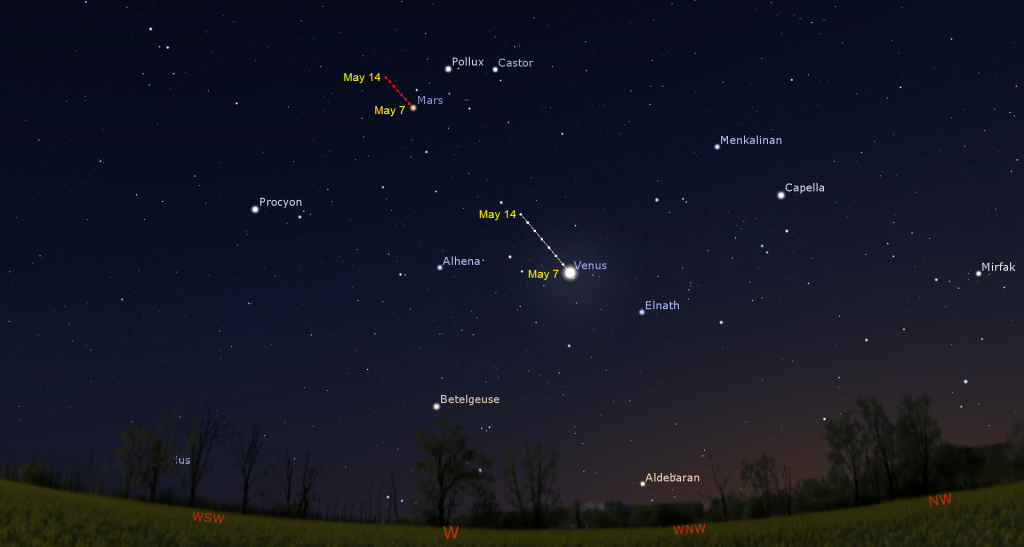
Venus will set at about midnight this week. Each night, the stars around it will drop a little lower and sunward, causing Venus to shift “higher” compared to them. For several nights surrounding Tuesday, the orbital motion of Venus will carry it past the large open star cluster in Gemini known as Messier 35 or the Shoe-Buckle Cluster. Since last week the planet and the cluster have been close enough to share the view in binoculars, with M35 sparkling to Venus’ left (or celestial southeast). At their closest approach on Tuesday night, the cluster will be positioned just a thumb’s width to the lower left (or 1.8 degrees south) of Venus. That will be close enough to see them together in a backyard telescope, but you may need to hide bright Venus just out of view to better see the patch of stars, which covers an area larger than the moon. After Tuesday, Venus will climb away from the cluster, but the pair will continue to share binoculars until Saturday.
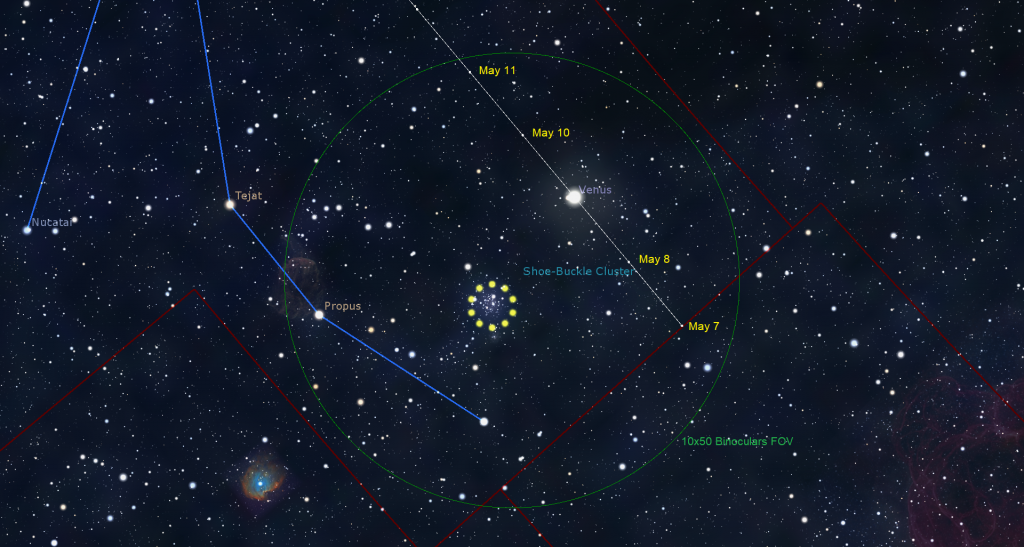
Viewed in a telescope, our sister planet will display a slightly gibbous, 62%-illuminated disk that is waning daily. To see the planet’s shape most clearly, wait until the sun has fully set and then aim your telescope at Venus while the sky is still bright. That way Venus will be higher and shining through less intervening air – and her glare will be lessened.
Mars will temporarily become a member of the Arch of Spring this week while it travels eastward past the stars Pollux and Castor in Gemini (the Twins). In the sky Mars will be positioned to the lower left of those stars, which will appear to drop lower a little each night. The planet’s reddish, magnitude 1.4 dot will appear a bit fainter than Pollux and a bit brighter than Castor. Like Venus, Mars will look best in a telescope while it’s perched on high – but it will look tiny under any magnification. Mars will set at about 1:30 am local time.
On Saturday night, the minor planet designated (1) Ceres, the largest object in the main asteroid belt, will cease its motion across the background stars – completing a westerly retrograde loop that it began in February. The magnitude 7.9 object, which is visible in binoculars and backyard telescopes, will be creeping downward on the border between the constellations of Coma Berenices (Berenice’s Hair) and Leo (the Lion), two finger widths to the left (or 2 degrees to the celestial east) of the very bright star Denebola. In the last week of May, Ceres will cross into Virgo (the Maiden) as it gradually resumes its regular eastward motion.

If you are up and outside between 4:30 and 5 am local time, and you have a clear view of the east-southeastern horizon, watch for the prominent, yellowish dot of Saturn shining among the faint stars of Aquarius (the water-Bearer). If the sky hasn’t brightened too much yet, look for the four corner stars of the Great Square of Pegasus (the Flying Horse) over the eastern horizon well to the left of Saturn.
Jupiter is gradually increasing its distance from the morning sun, but the tilt of the morning ecliptic is keeping the big planet very low in the sky before sunrise, requiring an open view toward the east to have any chance of seeing it. Observers at mid-northern latitudes will start seeing Jupiter quite easily in a few weeks time – but, if you live at a southerly latitude, it’ll show up much sooner than that. A good thing, too – because there will be lots of occasions to see the shadows cast by its four Galilean moons crossing the planet’s disk in pairs during May!
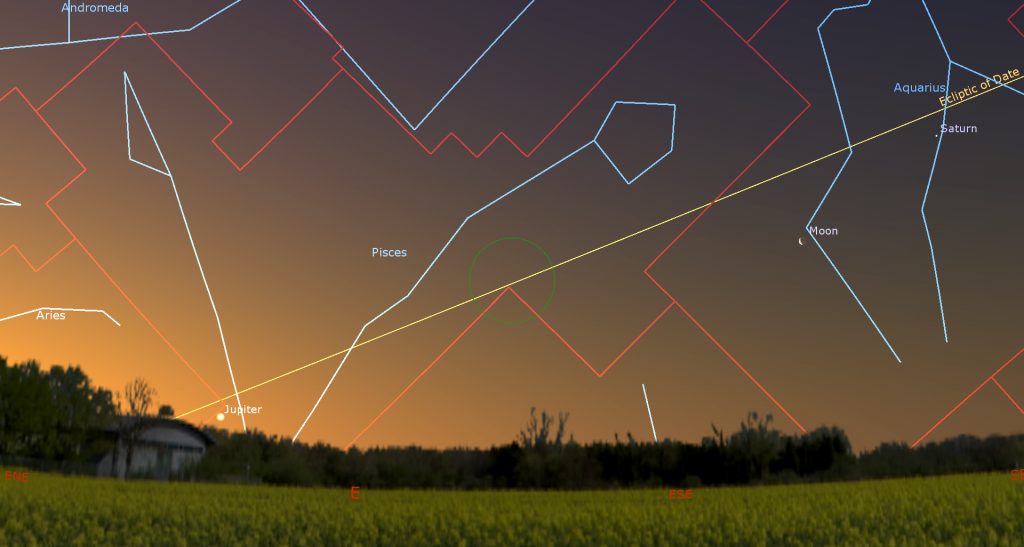
Dark Sky Sights
This week will give everyone dark, moonless evenings. Since the sky will get dark at a not-too-late hour and the black flies and mosquitoes are (mostly) yet to appear for mid-northern latitude stargazers, I’m going to share a lot of deep sky targets you can view. First up – some relatively easy to find galaxies!
Every spring in the Northern Hemisphere, the obscuring stars, gas and dust of our home galaxy the Milky Way vacate the night sky overhead, leaving a literal window of opportunity for us to see distant galaxies. The moonless nights from the middle of this week through May 22 offer the last good period to view distant galaxies in 2023. Your best time to begin viewing them arrives once the sky becomes fully dark, after about 10:15 pm local time this week.
On the next clear night, head outside, find a safe spot away from city lights, and look south. Nearly overhead, to the upper right of the very bright star Arcturus, you’ll find the modest, three-star constellation of Coma Berenices, or “Berenice’s Hair.” Within this corner-shaped figure sits the north galactic pole (NGP). It’s as far as you can get from the plane of the Milky Way – so the sky there is especially uncluttered by dimming gas and dust – letting us see for millions of light-years – to other island universes.

The NGP’s position high in the sky is also ideal for viewing distant galaxies through the minimum amount of Earth’s distorting atmosphere. Coma Berenices and the constellations around it – Virgo (the Maiden), Leo (the Lion), Ursa Major (The Big Bear, and the Big Dipper’s home) and Canes Venatici (the Hunting Dogs) – all host a great many galaxies.
If you have a medium-sized telescope (say 4” or 102 mm in aperture, or larger) and a dark location that is relatively free of light pollution, put your lowest power eyepiece (or lens) in it. That’s the one with the largest number printed on it. That long focal length eyepiece will display the largest possible patch of sky through the telescope – making finding galaxies easier. (Once you’ve found them, then you can swap in a stronger eyepiece and zoom in.)
At 10 pm local time, the distinctive constellation of Leo sits more than halfway up the southern sky. Medium-bright stars arranged in a backwards question mark form his west-facing head and chest. Leo’s brightest star Regulus is at the bottom of the question mark. We’re interested in the lion’s other end…
Aim your telescope at the medium-bright star named Denebola, which marks the tail of Leo (the Lion). It is 2.5 fist diameters to the left (or celestial east) of Regulus. Focus your telescope until Denebola is a sharp pinpoint of light. Next, without changing the focus, swing your telescope to a spot exactly midway between Denebola and the medium-bright star Vindemiatrix in Virgo (the Maiden), which sits nearly two outstretched fist diameters to the lower left (or 17 degrees to the celestial east) of Denebola.
If your sky is dark and your eyes are dark-adapted, you should see a number of dim fuzzy patches of light in the eyepiece. Those are galaxies! They are members of the Virgo Cluster of Galaxies – some larger, some smaller. If you aren’t sure you’re seeing them, try lightly tapping telescope tube while you are looking. The smudges will jump around a little, allowing your brain’s wiring to see them better. Using small movements of the telescope, scan around to see how many you can find in that region of the sky. Use the small stars around the galaxies to focus your telescope. If you get lost, just start over!
The region of sky below Leo, on a line between Denebola and Regulus, contains two small groups of brighter galaxies. The eastern group, known as the Leo Triplet of Galaxies, consists of three spiral galaxies, Messier 65, Messier 66, and the Hamburger Galaxy, aka NGC 3628. The trio will share the field of view of a telescope at low magnification. All three galaxies are relatively bright due to their near edge-on orientations. You can also get to them by aiming your telescope about three finger widths below (or 2.6° to the celestial southeast of) the medium-bright star Chertan.
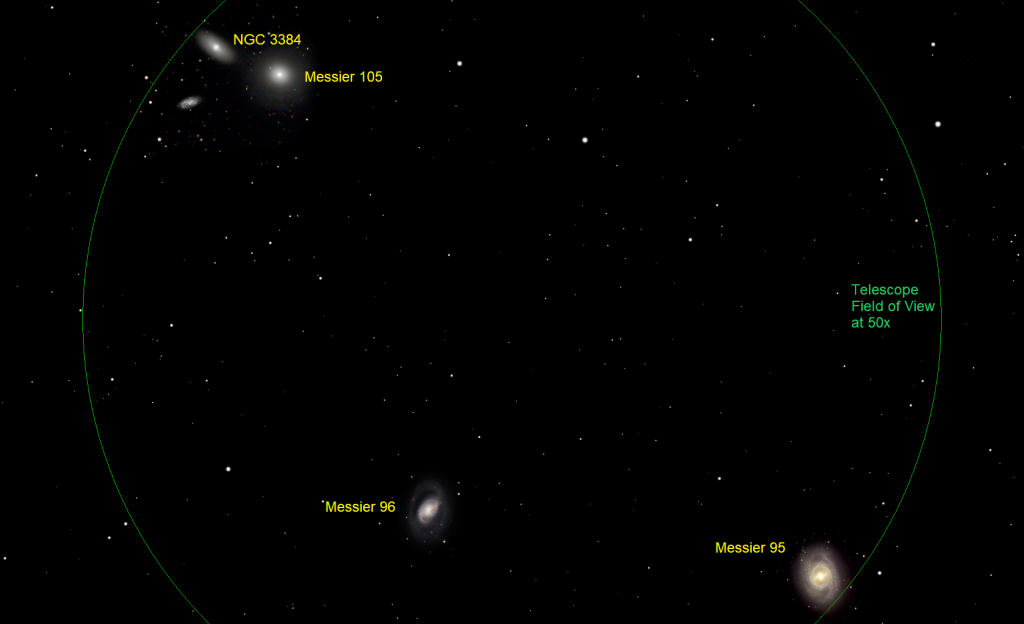
The second galaxy group is located mid-way between the Leo Triplet and Regulus. The close pair of galaxies M105 and NGC 3384 resembles headlights in the fog when viewed in a telescope. Two more galaxies, M95 and M96, are a finger’s width below (or 1 degree to the south of) those “eyes”.
Now look straight up and locate the seven bright stars of the Big Dipper. The bright star Alkaid marks the tip of the dipper’s handle. Two impressive galaxies can be seen near that star in binoculars and backyard telescopes under dark sky conditions. If you face east and look up, the Pinwheel Galaxy, a spectacular, large face-on spiral galaxy also designated as Messier 101, sits a palm’s width to the lower left (or 5.5 degrees to the celestial north) of Alkaid. The galaxy forms an equilateral triangle with Alkaid and Mizar, the double star where the handle bends. This relatively close galaxy (21 million light-years away) is nearly as large as the full moon in the sky – but with the galaxy’s light spread over such a large area, its overall brightness is low.
If you search the sky a few finger widths above and to the right (or 3.5 degrees to the southwest of) Alkaid, you will come to the iconic spiral Whirlpool Galaxy, aka Messier 51. This galaxy’s angular size is smaller, but it will appear brighter in your binoculars and telescope because its light is concentrated more. Messier 51 has a secondary galaxy core designated NGC 5195 right beside it – linked by a bridge of material. But you’ll need a larger telescope to see it clearly.
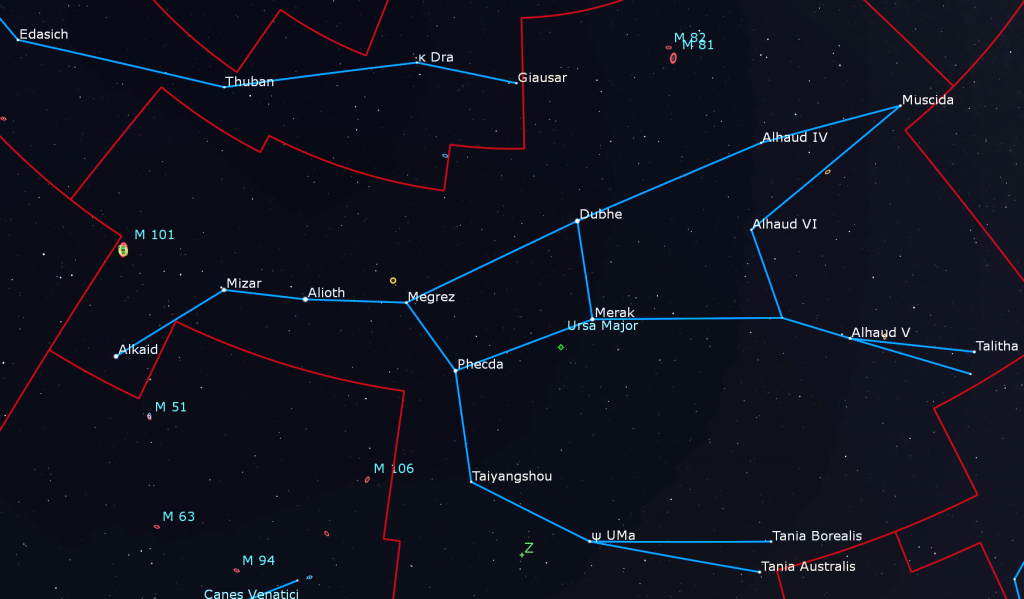
Drawing a line connecting the Big Dipper stars Phecda to Dubhe, and extending that line by an amount equal to their separation, brings you to the relatively bright galaxy named Bode’s Nebula, or Messier 81. (Astronomers used to think that galaxies were nebulas of gas.) A second galaxy named the Cigar Galaxy, or Messier 82, is located half of a degree to the north of Bode’s Nebula. Both galaxies can be seen in the same telescope field of view.
Bode’s Nebula is a magnitude 6.9 spiral galaxy oriented not quite face-on to Earth, making it larger and brighter than the Cigar Galaxy, which is smaller, but bright due its nearly edge-on orientation. Several other dimmer galaxies can be found within a few degrees of those two.
If you double that line from Dubhe to Phecda, but in the opposite direction, you’ll find another medium-sized spiral galaxy named Messier 106. Okay – that will get you started. Now on to other types of objects!
During May, the best globular star clusters observable from mid-northern latitudes become well-placed in the eastern evening sky. Globular star clusters, or globulars, are densely packed, spherical concentrations of old stars that orbit our galaxy’s core – but mainly outside of the galaxy’s disk. Containing hundreds of thousands to millions of stars, they might even be the cores of former galaxies that our Milky Way’s gravity has stripped the gas and dust from and taken captive, gravitationally speaking.
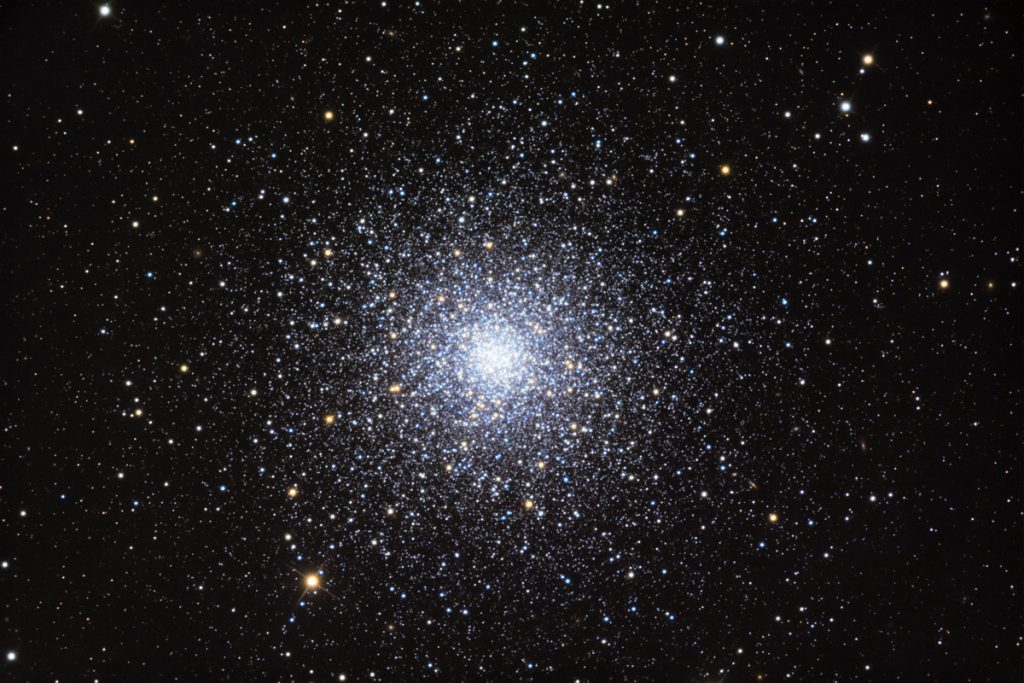
In early evening, look for 7.7 magnitude Messier 53 (or M53) in Coma Berenices (Berenice’s Hair) and the spectacular magnitude 6.2 Messier 3 (M3) in Canes Venatici (the Hunting Dogs). If you face southeast, M53 is located just to the left of the medium-bright star Diadem. M3 is located a fist’s diameter above the very bright star Arcturus. Scan around with binoculars and look for them as fuzzy stars.
As the evening wears on, Messier 5 (aka the Rose Cluster) in Serpens Caput (the Snake’s Head) and Messier 92 in Hercules will be carried higher, making them easier to see. Both of those globulars also shine at an easy magnitude 6.5. For the finale, spend some time enjoying the brightest one – the Great Hercules Cluster, aka Messier 13. All of these objects will reach their highest altitudes and best appearance, in the hours after midnight.
I’ll post sky charts showing where to find these objects here. Enjoy your viewing!
Delving into the Dippers
If you missed last week’s guide to the Big Dipper and the Little Dipper I posted it here.
Eta-Aquariids Meteor Shower
The annual Eta-Aquariids Meteor Shower, produced when Earth travels through a cloud of particles of material left behind by repeated passages of Halley’s Comet, will taper off over the next couple of weeks – so keep an eye to the sky on clear nights.
Public Astro-Themed Events
Every Monday evening, York University’s Allan I. Carswell Observatory runs an online star party – broadcasting views from four telescopes/cameras (weather permitting), answering viewer questions, and taking requests! Details are here. They host in-person viewing on the first clear Wednesday night each month. On Wednesdays they stream views online via the observatory YouTube channel. Details are here.
My free, family-friendly Insider’s Guide to the Galaxy webcast with RASC National returns on Tuesday, May 11 at 3:30 pm EST. Panelists will talk about ways to encourage and support girls and young women to take up astronomy. Then we’ll highlight our next batch of spring RASC Finest NGC objects. You can find more details and the schedule of future sessions here.
Keep looking up, and enjoy the sky when you do. I love questions and requests. Send me some!
One Response
Thanks, Chris. Learned about the Arch of Spring asterism! Thanks.